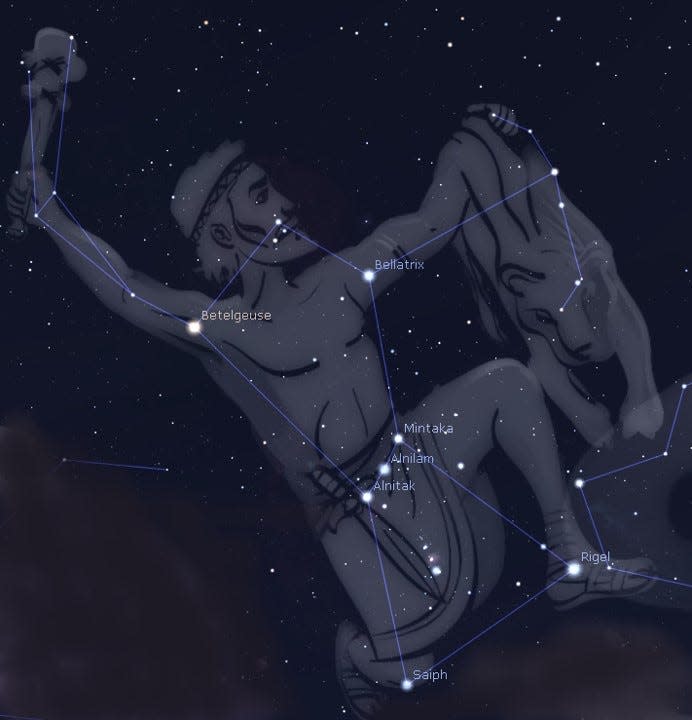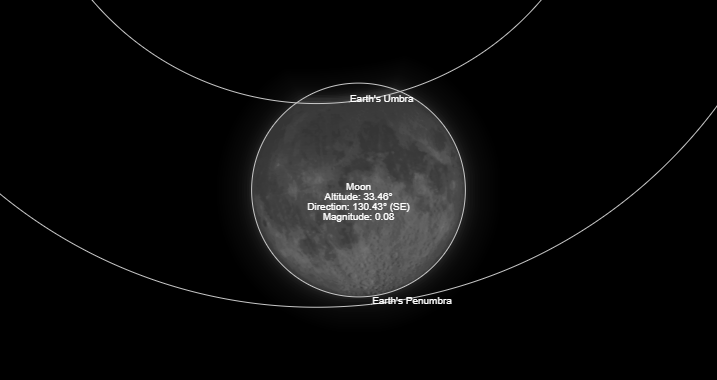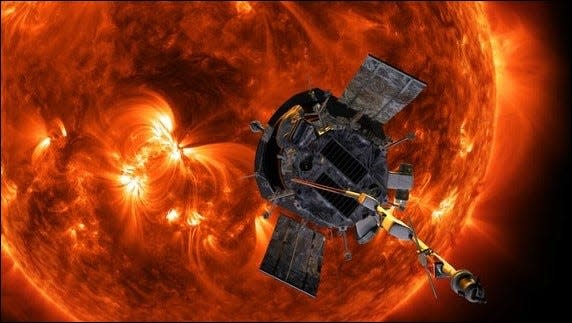Sky Shorts: Celestial, space highlights for 2024

Without a doubt, the total solar eclipse on Monday, April 8, will be the grandest event of the year!
A large portion of Ohio will experience one of the most awe-inspiring events that we can witness on Earth – this is a once in a lifetime event!
To see the total solar eclipse, you need to be in the path of totality. Unfortunately, the city of Canton is just outside the path of totality. Other locations in Stark County, though, will be able to enjoy the show. While North Canton, Lake Township, Hartville and Canal Fulton, plus Green in Summit County, will be in the path, totality there will be around two minutes or less.
Now is the time to come up with your plan to view this phenomenal event. The eclipse timeline for Canton is partial eclipse begins at 1:59 p.m., maximum eclipse begins at 3:15 p.m., and partial eclipse ends at 4:29 p.m.
Visit www.timeanddate.com to determine the exact timing for locations in the path of totality. If you are feeling adventurous, cities such as Avon Lake, Cleveland and Lorain are on the central line, which will feature totality for almost four minutes.
Viewing safely will be the biggest concern. You must wear solar filter glasses to view the sun. Never look at the sun directly! The only time you can safely look at the sun is during totality! When purchasing solar filter glasses look for the international standard requirement code of ISO 12312-2. The American Astronomical Society has published a list of reputable solar glass vendors. The list of vendors can be found at eclipse.aas.org/resources/solar-filters.
Other night sky highlights for 2024
March 25 – Penumbral lunar eclipse. The moon will pass through the outer shadow of Earth, which creates a subtle difference. The penumbral eclipse begins at 12:53 a.m., maximum is at 3:12 a.m. and the eclipse ends at 5:32 a.m.
May 18 – National Astronomy Day.
July – Venus returns to the evening sky later in the month.
Aug. 19 – Seasonal Blue Moon. This will be the third of the four full moons in a season.
Sept. 8 – Saturn at opposition, viewable from dusk to dawn.

Sept. 17-18 – Very partial lunar eclipse. A very small portion of Earth’s umbra shadow eclipses the moon. Partial eclipse begins at 10:12 p.m, maximum at 10:44 p.m and partial ends at 11:15 p.m.
Sept. 18, Oct. 17 and Nov. 16 – Closest full moons or supermoons.
Dec. 7 – Jupiter at opposition, viewable from dusk to dawn.
Space exploration highlights for 2024
NASA’s Europa Clipper is scheduled to launch Oct. 6. It will explore Jupiter’s moon Europa and determine whether its underground ocean is habitable.
NASA’s Artemis II target launch date is November 2024. Artemis II is the first crewed mission on NASA’s journey to establishing a long-term presence on the Moon. This mission will be a 10-day flight that takes the crew around the moon.
NASA’s Parker Solar Probe will come within 3.9 million miles of the Sun’s surface, its closest approach, in December 2024. This is seven times closer to the Sun than any spacecraft. Parker launched in 2018 with the mission of making observations of the outer corona of the Sun.

NASA’s EscaPADE mission, expected to launch in August, consists of dual spacecraft helping to study Mars’ unique hybrid magnetosphere.
NASA SpaceX Crew 8 launches in mid-February and Crew 9 in mid-August to the International Space Station (ISS).
Also headed to the ISS is the first crewed flight of Boeing’s CST-100 Starliner, with a possible launch date, at the earliest, sometime in March. Starliner can carry up to seven passengers but only two will be at the controls for the spring launch, astronauts Barry “Butch” Wilmore and Suni Williams.
Night Sky for January
Three months until the Total Solar Eclipse!
Planets and the moon
As we welcome in the New Year, Jupiter and Saturn are continuing to put on a show in the evening sky. After sunset, stunning Jupiter is high in the southern sky. It starts the month shining at magnitude -2.6 and dims to -2.4 by month’s end. It is visible until midnight, offering great telescope and binocular viewing. The four largest Galilean Moons are easy to spot through a backyard telescope. You will notice how the moons change positions each night. Using binoculars, be as steady as possible, looking for the pinpoints of light around Jupiter, which are the Galilean moons. The Moon pairs with Jupiter on Jan. 17-18.
Saturn can be found 30 degrees high in the southwestern sky an hour after sunset, shining at magnitude 0.9. Saturn sets by 9:00 p.m. on Jan. 1 and by 7:30 p.m. on Jan. 31. Saturn is a lovely sight in a telescope. A beautiful crescent Moon will pass by Saturn on the nights of Jan. 13-14.
Neptune stands 20 degrees east of Saturn, at magnitude 7.8, and sets around 8:00 p.m. by month’s end. It is located in Pisces, just south of the Circlet asterism and five degrees south of Lambda Piscium, at the start of the month. The Moon passes south of Neptune on Jan. 15. Binoculars are needed.
Uranus is located in eastern Aries, at magnitude 5.7, halfway between Jupiter and the Pleiades star cluster. Binoculars are needed. The Moon passes north of Uranus on Jan. 19.
Venus continues to shine bright in the southeastern predawn sky at magnitude -4.0, rising three hours before the Sun. The bright star Antares is just below Venus at the start of the month. The crescent Moon is just south of Venus on Jan. 8.
Mercury shines at magnitude -0.1 in early January right before sunrise. On Jan. 9, the waning crescent moon passes south of Mercury. Mercury reaches greatest western elongation on Jan. 12 and will be found 24 degrees high in the southeast. Also, Mercury will move closer to Venus until Jan. 17. On this day, the two planets will be eleven degrees apart. Then Mercury begins to separate from Venus and falls back towards the Sun.
The first opportunity to spot Mars, in the predawn sky, could be Jan. 19 when Mars stands five degrees east of Mercury. Binoculars will help. Mars and Mercury continue to move closer together until Jan. 27 when they will be less than one degree apart. You will need a telescope to spot Mars near Mercury. Venus can be used as a guide. It shines up and to the left of the pair.
Night sky spotlight
This month’s spotlight features the most magnificent picture in the stars, Orion, the Hunter. Orion, the most recognizable constellation in the world, was among the 48 constellations listed by 2nd century astronomer Ptolemy.
Orion lies on the celestial equator, and it can be viewed in both the Northern and Southern hemisphere. Step out on the next clear night and look east-southeast. You will easily see the three stars in a row that make up the belt of Orion. Then look for the four stars that outline the Hunter. Just in that constellation alone, there are so many celestial treasures, a very old star, new stars, giant stars, bright stars and hot and cool stars! The brightest star in Orion is Rigel, which is down and to the right of the belt, marking the foot or knee. It is a blue supergiant and the seventh brightest star. The second brightest is Betelgeuse which marks the shoulder. Betelgeuse is a red supergiant and the tenth brightest star. Betelgeuse’s life is almost over and will end in a supernova. This star is 800 times larger than our Sun! The three stars in the belt are, from east to west, Alnitak, Alnilam and Mintaka. If you grab a pair of binoculars and scan below the belt stars you will spot a cloudy patch. This is the Orion Nebula, the birthplace of stars. Brand new stars are forming in that hydrogen gas cloud. This nebula is 1400 light years away and you can view it from your backyard! So, bundle up and enjoy this magnificent constellation!
The peak of the Quadrantid Meteor Shower is Jan. 4.
For further night sky details, maps and audio, visit my website www.starrytrails.com.
Visit the Hoover Price Planetarium
Visit www.mckinleymuseum.org, for show dates and times! Planetarium shows are free with Museum admission. The Planetarium is located inside the McKinley Presidential Library & Museum, 800 McKinley Monument Drive, N.W., in Canton, Ohio. For more information, please call the Museum at 330-455-7043

This article originally appeared on The Alliance Review: Sky Shorts: Celestial, space highlights for 2024

